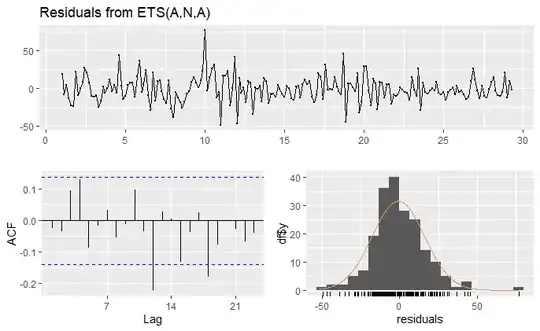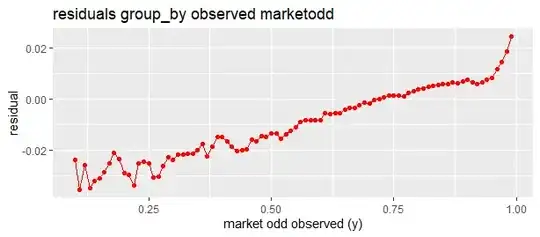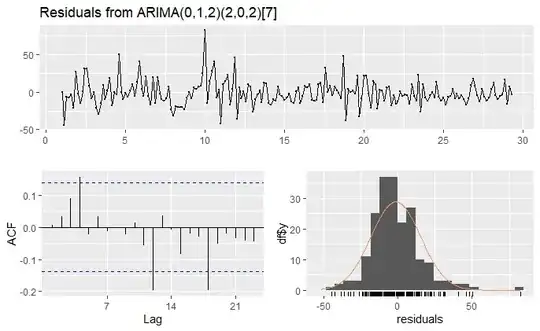I have been learning time-series forecasting recently and I am trying to understand the procedure. I would like to find the best model for a daily time series, so far I tried exponential smoothing with ets and also ARIMA with auto.arima, but when I pass both models to Ljung-Box test, they both fail. I would like to know how I could improve the forecast here since I am relatively new and have many questions as I would like to learn more and dive deeper into this field. For example I am familiar with improving the forecast of linear models with AR models where we apply an ARIMA model on the residuals and improve it. But about ets and ARIMA models I am not sure.
Here are the results:
# The forecast for 14 days ahead
auto.arima(ts_d) %>%
forecast(h = 14) %>%
autoplot()
and also the result of Ljung-Box test:
checkresiduals(auto.arima(ts_d))
Ljung-Box test
data: Residuals from ARIMA(0,1,2)(2,0,2)[7]
Q* = 16.683, df = 8, p-value = 0.03358
Model df: 6. Total lags used: 14
The result of exponential smoothing model:
ets(ts_d) %>%
forecast() %>%
plot()
And also the result of Ljung-Box test for exponential smoothing:
checkresiduals(ets(ts_d))
Ljung-Box test
data: Residuals from ETS(A,N,A)
Q* = 21.076, df = 5, p-value = 0.0007837
Model df: 9. Total lags used: 14
One more thing I don't understand is why I got an error message as follows when I apply a log transformation on my ARIMA model:
Error in auto.arima(ts_d, lambda = 0) : No suitable ARIMA model found In addition: Warning message: The chosen seasonal unit root test encountered an error when testing for the first difference. From stl(): NA/NaN/Inf in foreign function call (arg 1) 0 seasonal differences will be used. Consider using a different unit root test.
Here I also add a reproducible version of my ts:
structure(c(70, 4, 27, 25, 27, 6, 58, 44, 6, 29, 60, 65, 36,
36, 43, 0, 0, 22, 48, 19, 38, 58, 0, 20, 28, 90, 30, 28, 42,
9, 26, 42, 48, 42, 76, 49, 15, 49, 33, 32, 54, 34, 62, 22, 27,
24, 33, 47, 18, 13, 2, 10, 8, 13, 12, 20, 29, 7, 28, 26, 33,
36, 51, 114, 9, 42, 57, 75, 30, 41, 15, 28, 49, 62, 30, 37, 85,
9, 31, 32, 45, 27, 45, 59, 7, 19, 32, 44, 21, 49, 61, 12, 10,
24, 28, 36, 36, 43, 12, 15, 27, 21, 15, 35, 48, 6, 15, 36, 36,
36, 24, 28, 6, 30, 43, 18, 60, 32, 43, 14, 33, 37, 27, 30, 79,
3, 22, 29, 36, 26, 56, 13, 16, 44, 53, 34, 8, 53, 44, 4, 32,
38, 22, 29, 49, 18, 15, 14, 21, 29, 20, 36, 23, 3, 33, 24, 16,
45, 11, 34, 9, 14, 21, 23, 21, 39, 22, 3, 13, 6, 15, 18, 31,
15, 9, 9, 12, 9, 3, 15, 27, 30, 24, 12, 3, 18, 15, 9, 9, 21,
27, 9, 6, 12, 12, 30, 3, 24, 9), .Tsp = c(1, 29.2857142857143,
7), class = "ts")
Thank you very much in advance for your time and please forgive me if my question seems so basic as I am quite naive in the field but very eager to improve.



